使用Java来开发物联网应用
这是Hello, Lithosphere Tutorials系列教程中的其中一篇。
感觉介绍用C/C++,用Python来开发物联网应用的文章比较多,用Java来做物联网的文章比较少。
这篇文章,介绍如何使用Java技术来开发一个物联网的简单例子。我们从手机App上,遥控硬件板上的LED灯亮灯、熄灯、闪灯。
我们学习如何将树莓派硬件板连接到服务器,并使用Java代码来控制硬件板的GPIO。
当一切连通,我们通过手机App来遥控硬件板LED灯。
我们使用100%的纯Java代码来完成这一切。
以下,为教程的具体内容。
Hello, Actuator!!!
欢迎进入IoT的世界!!!让我们来学习如何让硬件板上的LED灯闪起来
在这第一篇教程中,让我们使用一块树莓派硬件板,通过GPIO连接LED灯。
然后,我们使用Lithosphere IoT平台提供的Actuator插件,只需要做简单的开发,我们就可以用App遥控IoT硬件板设备来让LED闪灯了。
1 前置条件:
Java = 8(树莓派端)
Java >= 11(服务器端)
Granite Lite IoT XMPP Server
点击这里下载Granite Lite IoT XMPP Server
Raspberry Pi Zero W硬件板
LED模块
几颗杜邦线
下图是这个教程中使用到的硬件。
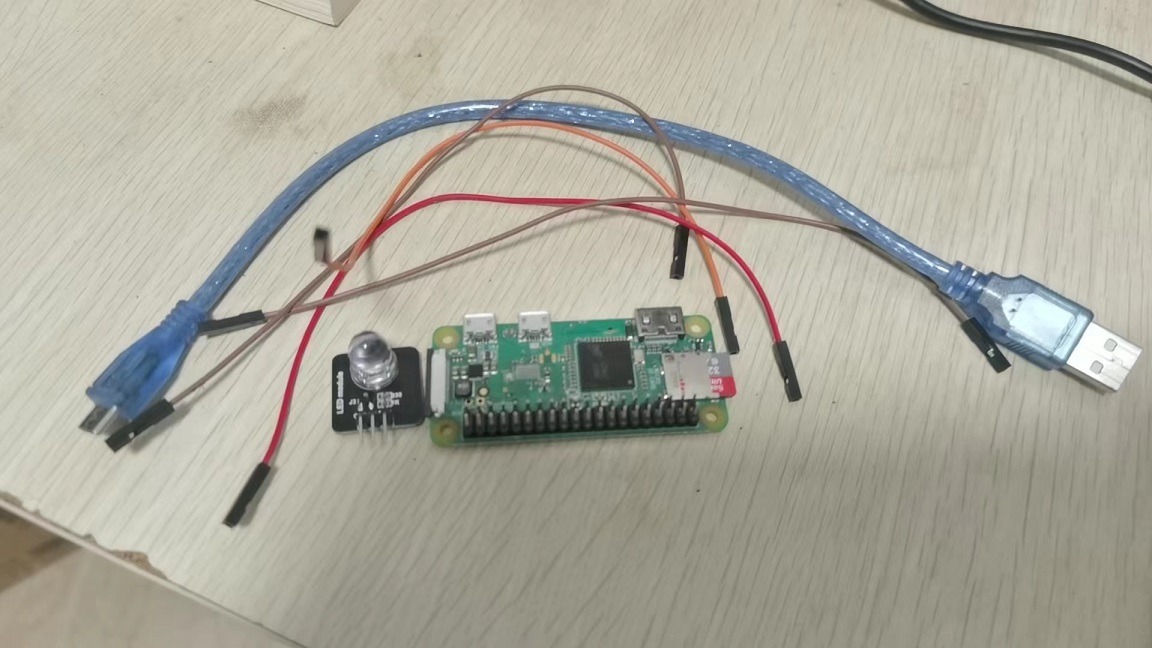
2 概念
这篇教程,会涉及到IoT设备的硬件控制接口,以及IoT终端设备的分发部署。简单介绍相关概念如下。
2.1 GPIO
GPIO是英文General-Purpose Input/Output的缩写。
简单来说,GPIO就是硬件板上一组引针,这些引针可以用来控制电信号输入输出。
由于这些引针是可以编程来控制的,从而可以实现和外部的电路模块板通讯。
下图是Raspberry Pi Zero W上的GPIO接口。
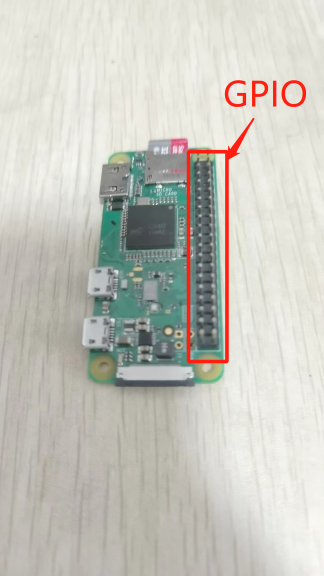
在本教程中,我们使用GPIO来连接外部的LED模块,从而实现LED小灯的程序控制。
2.2 设备注册
在真实的IoT应用中,当一个IoT设备从库房中拿出来时,它并不能接通电源后立马就开始工作。
基于安全性和利于管理的考虑,IoT设备要能够开始工作,需要经过一个“设备注册”的步骤。
在这个“设备注册”的过程中,应用一般会:
- 检查设备的合法性
- 检查设备是否在此时被允许进入网络
- 登记设备相关信息到系统中
- 配置设备 - 例如对设备进行网络配置;发放安全token等。
在不同的应用和不同标准中,“设备注册”可能会有不同的术语和叫法。
例如,在LoRaWAN标准中,“设备注册”被叫做"End Device Activation"。官方文档里,这样描述End Device Activation:
All end devices that participate in a LoRaWAN network must be activated. There are two methods of activation you can choose: over-the-air activation (OTAA) or activation by personalization (ABP).
Lithosphere IoT Platform基于XMPP通讯协议。在标准XMPP协议扩展XEP-0077 (In-Band Registration)里,定义了如何实现IM用户在线注册的功能。
遵从XMPP的习惯,Lithosphere IoT平台里的“设备注册”,被称为IBTR(In-Band Thing Registration),即智能物件在线注册。
Lithosphere IoT平台,已经内置实现了IBTR功能。基于服务器端和客户端的IBTR插件,可以快速开发及灵活定制“设备注册”功能。
在本篇教程中,我们会看到相关的内容。
3 安装和配置Raspberry Pi
树莓派Zero W,我在淘宝上买153元RMB,记住要买一个SD卡来插上。
我们需要做的第一件事,是给树莓派装上系统。
在没有监视器和键盘的情况下,给树莓派装上OS。在Raspberry Pi的官方的文档里,把这叫做Headless Setting Up。可以参考下面的链接,了解如何做Headless Setting Up。
官方Headless Setting Up文档
如果你不想阅读英文,可以看XDongger这篇关于树莓派安装和配置的文章。
安装和配置树莓派
4 连接硬件
我们先来看看LED模块长啥样。
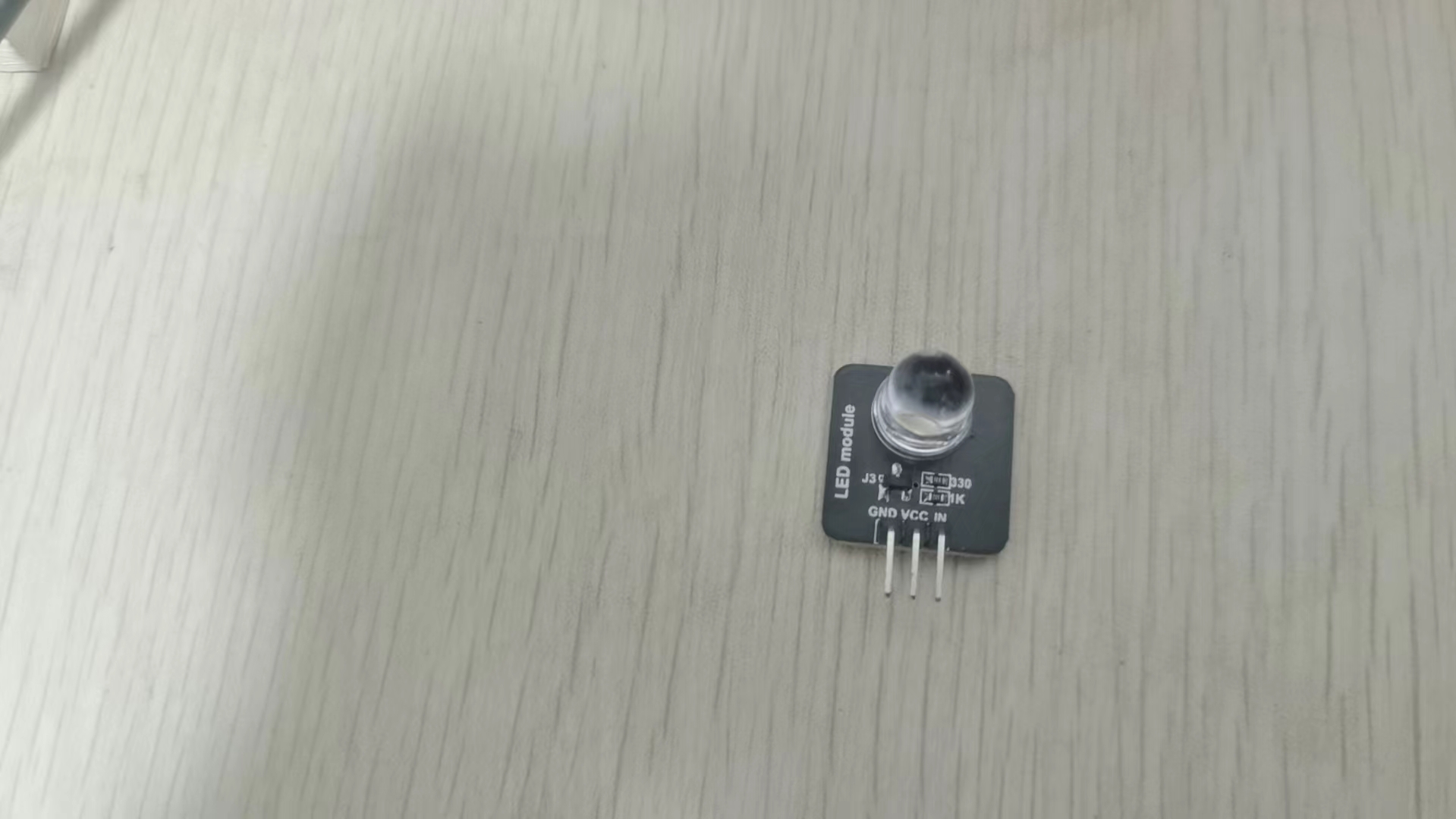
这个LED模块在淘宝上买,5块钱一个。
我们可以看到,它有3个引脚:
| 引脚名 | 作用 |
|---|---|
| GND | 地线 |
| VCC | 5V电源 |
| IN | LED控制 |
我们需要将LED模块,通过树莓派硬件板上的GPIO接口,连接到硬件板上。
如何对接呢?让我们我们来看看树莓派的GPIO接口。
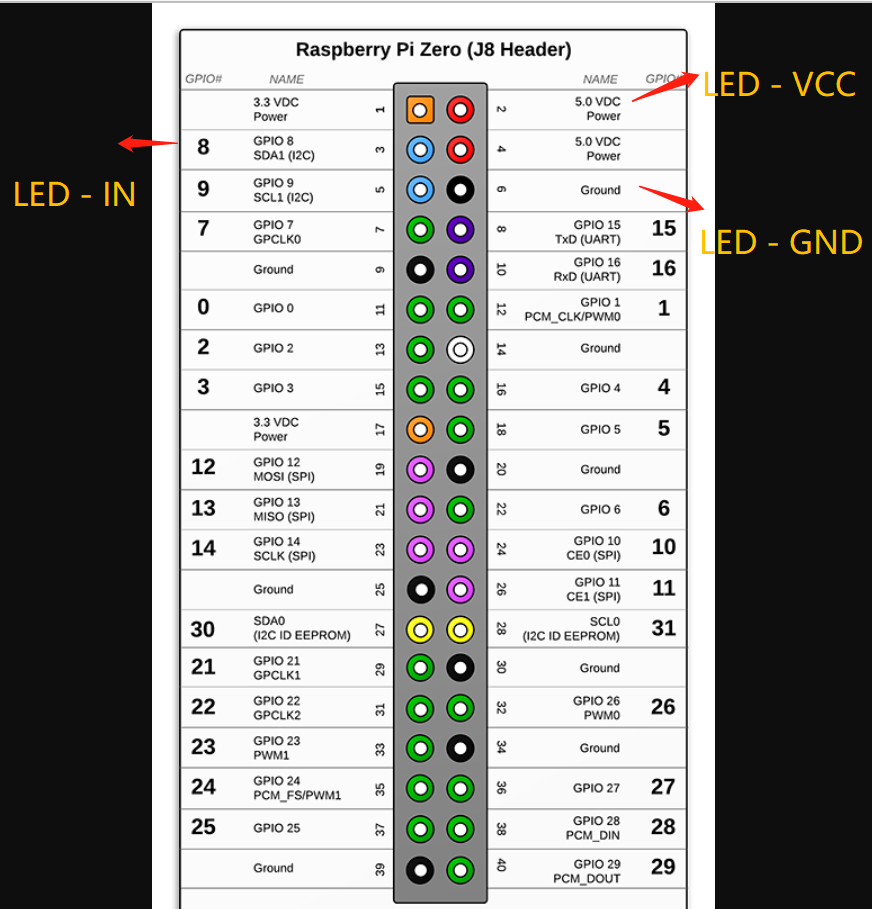
我们将LED的VCC接口,接在GPIO的5V Powerd引脚上。
我们将LED的GND接口,接在GPIO的Ground引脚上。
我们将LED的IN接口,接在GPIO 8引脚上。
接好后,看上去是这样的。
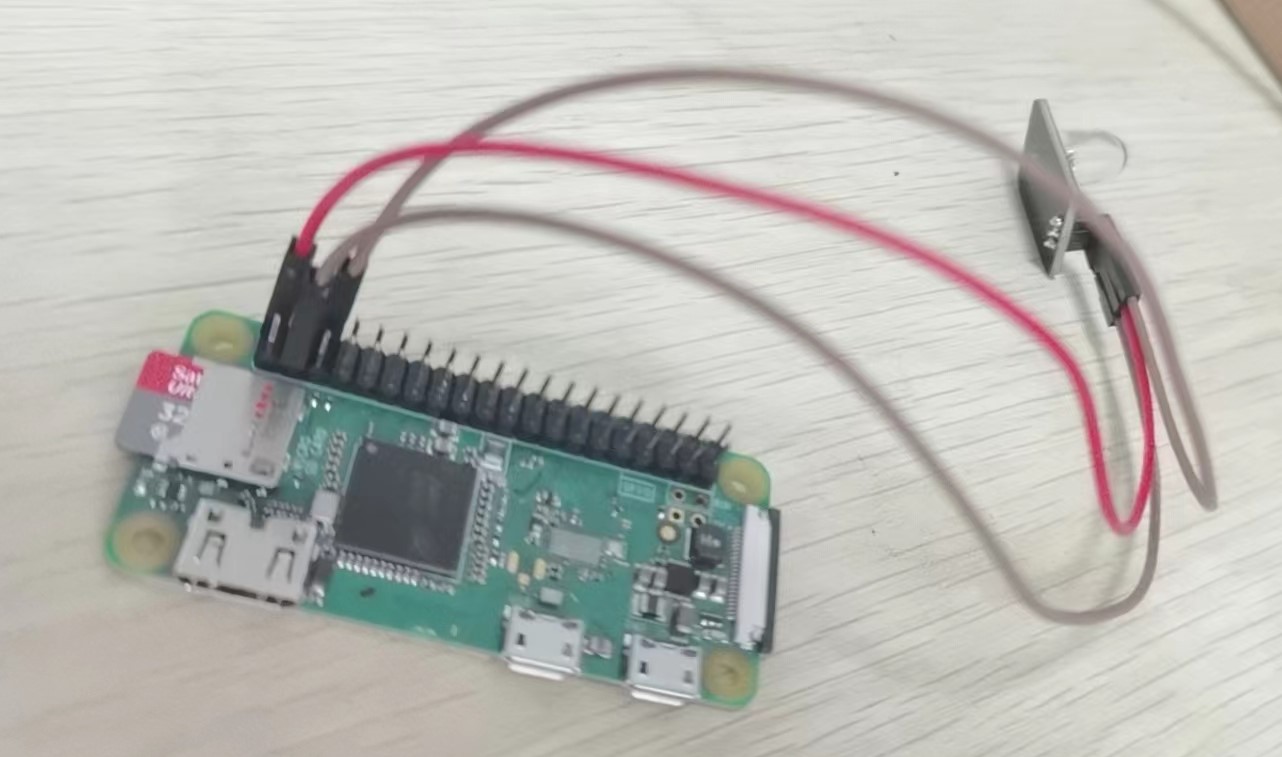
5 配置硬件板基础软件环境
在2 安装和配置Raspberry Pi步骤中,我们只是得到了一个初始化版本的RaspBerry Pi OS操作系统。要想在上面能运行Lithosphere IoT平台的终端程序,还得做以下的配置。
5.1 安装OpenJDK
登录到树莓派硬件板。
ssh pi@192.168.1.180
注:
- 192.168.1.180是树莓派板的网络地址。请改为你配置树莓派板时,指定的静态IP地址。
- pi为树莓派用户。请改为你配置树莓派时,初始化创建的用户名。
执行以下指令安装OpenJDK 8。
sudo apt-get install openjdk-8-jdk
注:
- 为何要安装OpenJDK 8版本?
Raspberry Pi OS默认自带的OpenJDK版本是OpenJDK 11。这意味着,如果你执行以下指令。系统会默认安装OpenJDK 11。
sudo apt-get install default-jdk
这个默认版本的JDK,在Raspberry Pi Zero W上不能正常工作。原因是因为Raspberry Zero W使用ARMv6版本CPU。而Raspberry Pi OS默认带的OPenJDK 11,仅适用于ARMv7和ARMv8版本的CPU。
当然,有一些其它办法可以在Raspberry Pi Zero W上来安装OpenJDK 11。
在这篇教程里,我选择改装OpenJDK 8的解决方案。看上去,这是一个简单有效的解决方案。
5.2 安装WiringPi
我们在后续开发中,会使用Pi4J库V1.3版本来控制GPIO。Pi4J是一个开源Java库,它使用JNI来调用C程序编写的WiringPi库来控制GPIO。
所以,我们需要安装WiringPi。
Raspberry Pi OS并没有自带WiringPi软件包。我们通过以下指令安装WiringPi。
wget https://github.com/WiringPi/WiringPi/releases/download/2.61-1/wiringpi-2.61-1-armhf.deb
sudo dpkg -i wiringpi-2.61-1-armhf.deb
6 开发协议包
为何我们需要单独开发一个包含协议对象的协议包?
这是因为我们使用叫OXM(Object-XMPP Mapping)的技术。简单来说,我们希望在开发中,能够屏蔽掉XMPP协议实现的细节,简化开发过程。
关于OXM,可以参考概念文档中的OXM章节
使用OXM,我们会定义的协议对象,这些协议对象,在客户端和服务器端,都会被使用。协议对象是可复用的。
所以,我们最好开发一个单独的协议包,已便于在后面客户端和服务器端复用这些协议对象。
6.1 创建协议工程
创建hello-actuator-protocol工程,pom.xml如下:
<?xml version="1.0" encoding="UTF-8"?>
<project xmlns:xsi="http://www.w3.org/2001/XMLSchema-instance"
xmlns="http://maven.apache.org/POM/4.0.0"
xsi:schemaLocation="http://maven.apache.org/POM/4.0.0 http://maven.apache.org/maven-v4_0_0.xsd">
<modelVersion>4.0.0</modelVersion>
<parent>
<groupId>com.thefirstlineofcode.basalt</groupId>
<artifactId>com.thefirstlineofcode.basalt</artifactId>
<version>1.1.0-RELEASE</version>
</parent>
<groupId>com.thefirstlineofcode.lithosphere.tutorials.helloactuator</groupId>
<artifactId>hello-actuator-protocol</artifactId>
<name>Hello actuator protocol</name>
<version>0.0.1-RELEASE</version>
<dependencies>
<dependency>
<groupId>com.thefirstlineofcode.basalt</groupId>
<artifactId>basalt-oxm</artifactId>
</dependency>
</dependencies>
<repositories>
<repository>
<id>com.thefirstlineofcode.releases</id>
<name>TheFirstLineOfCode Repository - Releases</name>
<url>http://120.25.166.188:9090/repository/maven-releases/</url>
</repository>
</repositories>
</project>
代码说明
- 指定parent为com.thefirstlineofcode.basalt:com.thefirstlineofcode.basalt,这样可以直接引用basalt parent pom的依赖管理配置。
- 因为要使用OXM(Object-XMPP Mapping),所以依赖basalt-oxm库。
- 目前,Lithosphere的开源库,仅被部署在TheFirstLineOfCode的私有的maven服务器上。为了构建时能够正确找到开源依赖库,需要配置com.thefirstlineofcode.releases的repository。
<repositories>
<repository>
<id>com.thefirstlineofcode.releases</id>
<name>TheFirstLineOfCode Repository - Releases</name>
<url>http://120.25.166.188:9090/repository/maven-releases</url>
</repository>
</repositories>
6.2 定义协议对象
在Hello,Actuator例子里,我们想用App来遥控IoT设备上的LED灯。我们希望可以遥控LED执行:亮灯、熄灯、闪灯。
为此,我们使用以下3个协议对象:
TurnOn
@ProtocolObject(namespace="urn:leps:things:simple-light", localName="turn-on")
public class TurnOn {
public static final Protocol PROTOCOL = new Protocol("urn:leps:things:simple-light", "turn-on");
}
TurnOff
@ProtocolObject(namespace="urn:leps:things:simple-light", localName="turn-off")
public class TurnOff {
public static final Protocol PROTOCOL = new Protocol("urn:leps:things:simple-light", "turn-off");
}
Flash
@ProtocolObject(namespace="urn:leps:things:simple-light", localName="flash")
public class Flash {
public static final Protocol PROTOCOL = new Protocol("urn:leps:things:simple-light", "flash");
private int repeat;
public Flash() {
this(1);
}
public Flash(int repeat) {
setRepeat(repeat);
}
public int getRepeat() {
return repeat;
}
public void setRepeat(int repeat) {
if (repeat < 1)
throw new IllegalArgumentException("Attribute repeat must be a non-zero positive integer.");
this.repeat = repeat;
}
@Override
public String toString() {
return String.format("Flash[repeat=%d]", repeat);
}
}
代码说明
- OXM框架会帮我们将Project Object转换成XMPP协议文档。当Flash对象的repeat属性值设置成5时,会生成下面的XMPP协议文档:
<flash xmlns="urn:leps:things:simple-light" repeat=5/>
- 不需要担心"urn:leps:things:simple-light"字符串太长了,会带来传输效率的低下。在Lithosphere IoT平台下,如果使用BXMPP技术,ProtocolObject(namespace="urn:leps:things:simple-light", localName="flash")这段协议头信息,会被转化成3字节长度的二进制协议信息。
- TurnOn和TurnOff,表达一个不带任何参数的指令,所以它们被设计成不带任何实例属性的空对象。
6.3 定义Model Descriptor
让我们来给要控制的IoT设备,定义一个Model Descriptor。
为何需要定义Model Descriptor?
这是因为Lithosphere完全基于插件架构。在插件架构下,系统功能并不是写死固化的。当一个插件被部署时,它为系统提供了一组应用功能。当这个插件被卸载掉后,它所提供的功能就消失了。
正是因为这种插件架构的特性,默认系统是不认识任何IoT设备的,也不能识别任何IoT控制/数据协议。
当我们基于插件技术,使用XMPP扩展协议,开发了某种IoT设备的一组应用功能。我们需要使用平台提供的扩展点,将插件提供的应用功能注册到系统中。我们需要明确的告知系统:现在,我们有这些功能了,相关功能由XXX插件提供。
最好是能有一个从设备维度专门描述IoT设备的对象,能够便利我们将相关信息提供给系统。
这个事说起来啰嗦,实操起来其实比较简单。我们需要在协议包里,定义一个Model Descriptor类。
public class HatModelDescriptor extends SimpleThingModelDescriptor {
public static final String MODEL_NAME = "HAT";
public static final String DESCRIPTION = "Hello Acuator Thing";
public HatModelDescriptor() {
super(MODEL_NAME, DESCRIPTION, false, null, null, createSupportedActions());
}
private static Map<Protocol, Class<?>> createSupportedActions() {
Map<Protocol, Class<?>> supportedActions = new HashMap<>();
supportedActions.put(Flash.PROTOCOL, Flash.class);
supportedActions.put(TurnOn.PROTOCOL, TurnOn.class);
supportedActions.put(TurnOff.PROTOCOL, TurnOff.class);
return supportedActions;
}
}
代码说明
- 继承SimpleThingModelDescriptor,这个基类实现了IThingModelDescriptor接口,提供了一些复用代码,可以让我们编写Model Descriptor时更省事。
- IoT设备的型号名。在这里,我们把这个被遥控闪灯的IoT设备型号叫做HAT,Hello Actuator Thing的缩写。
- 这个IoT设备是一个Actuator(执行器)设备,它接受Action指令,然后执行指令对应的操作。它不是Sensor,不需要上报数据。它也不触发事件,不需要事件通知功能。所以构造器里的参数都是false,null。只有最后一个构造器参数,我们用createSupportedActions(),将这个Actuator设备支持的Action都登记到Model Descriptor中。当然,在这个例子里,IoT设备只支持3个指令,TurnOn,TurnOff,Flash。
6.4 构建安装协议包
因为需要在后续开发客户端和服务器端插件包时,引用协议包,所以我们在hello-actuator-protocol工程里,执行构建安装指令,把协议包安装到本地maven仓库。
cd hello-actuator-protocol
mvn clean install
协议包已经开发完成,你可以参考官方开源仓库代码hello-actuator-protocol协议包工程源码
7 开发服务器端插件
7.1 服务器端插件工程
创建hello-actuator-server目录,添加pom.xml文件。
<?xml version="1.0" encoding="UTF-8"?>
<project xmlns:xsi="http://www.w3.org/2001/XMLSchema-instance"
xmlns="http://maven.apache.org/POM/4.0.0"
xsi:schemaLocation="http://maven.apache.org/POM/4.0.0 http://maven.apache.org/maven-v4_0_0.xsd">
<modelVersion>4.0.0</modelVersion>
<parent>
<groupId>com.thefirstlineofcode.sand</groupId>
<artifactId>sand-server</artifactId>
<version>1.0.0-BETA3</version>
</parent>
<groupId>com.thefirstlineofcode.lithosphere.tutorials.helloactuator</groupId>
<artifactId>hello-actuator-server</artifactId>
<version>0.0.1-RELEASE</version>
<name>Hello actuator server plugin</name>
<dependencies>
<dependency>
<groupId>com.thefirstlineofcode.sand.server</groupId>
<artifactId>sand-server-things</artifactId>
</dependency>
<dependency>
<groupId>com.thefirstlineofcode.lithosphere.tutorials.helloactuator</groupId>
<artifactId>hello-actuator-protocol</artifactId>
<version>0.0.1-RELEASE</version>
</dependency>
</dependencies>
<repositories>
<repository>
<id>com.thefirstlineofcode.releases</id>
<name>TheFirstLineOfCode Repository - Releases</name>
<url>http://120.25.166.188:9090/repository/maven-releases/</url>
</repository>
</repositories>
</project>
代码说明
- parent设置为com.thefirstlineofcode.sand:sand-server,可引用parent POM里的以来配置管理。
- 依赖com.thefirstlineofcode.sand.server:sand-server-things库,因为我们要使用这个库里的接口IThingProvider和IThingRegistrationCustomizer来实现相关功能。
- 依赖hello-actuator-protocol协议包。
7.2 实现IThingProvider
@Extension
public class ThingModelsProvider implements IThingModelsProvider {
@Override
public IThingModelDescriptor[] provide() {
return new IThingModelDescriptor[] {
new HatModelDescriptor()
};
}
}
代码说明
- 实现IThingProvider接口,在接口方法里,我们将前面开发的HatModelDescripotor登记到服务器中。
- 请注意@Extension标注,它申明了这个类是PF4J的插件扩展。
7.3 实现IThingRegistrationCustomizer
在这篇教程的前面章节,我们提到了“设备注册”。在Lithosphere平台里,“设备注册”被实现为IBTR(In-Band Thing Registration)协议。
Lithosphere IoT平台,提供一个IThingRegistrationCustomizer的接口,来允许开发人员定制设备注册的过程。
下面,我们来看看怎么使用IThingRegistrationCustomizer。
@Extension
public class ThingRegistrationCustomizer extends ThingRegistrationCustomizerAdapter {
private static final String HARD_CODED_REGISTRATION_CODE = "abcdefghijkl";
@Override
public boolean isUnregisteredThing(String thingId, String registrationCode) {
if (!super.isUnregisteredThing(thingId, registrationCode))
return false;
return HARD_CODED_REGISTRATION_CODE.equals(registrationCode);
}
@Override
public boolean isAuthorizationRequired() {
return false;
}
}
代码说明
- 继承ThingRegistrationCustomizerAdapter,这个类提供了IThingRegistrationCustomizer接口的默认实现。
- 重载了isUnregisteredThing方法,这个方法检查IoT设备的 Thing ID和Registration Code的合法性。我们看到,实现检查一个硬编码写死的Registration Code。
- isAuthorizationRequired(),返回false。我们在这个例子中,只检查Thing ID和Registration Code的合法性。不做人工的设备注册授权。所以我们关掉Authorization功能。
- @Extension标注申明这个类是PF4J的插件扩展。
7.4 编写插件配置文件
在src/main/resources目录下,创建plugin.properties。
plugin.id=hello-actuator-server
plugin.provider=TheFirstLineOfCode
plugin.version=0.0.1-RELEASE
plugin.dependencies=sand-server-things
non-plugin.dependencies=hello-actuator-protocol
代码说明
- plugin.dependencies,依赖sand-server-things插件。
- non-plugin.dependencies,依赖hello-actuator-protocol协议包(非插件格式jar)。
7.5 构建部署服务器端插件
构建hello-actuator-server插件包
cd hello-actuator-server
mvn clean package
将hello-actuator-server插件包和它依赖的hello-actuator-protocol包,把这两个jar包,copy到服务器的plugins目录下。
cp hello-actuator-protocol/target/hello-actuator-protocol-0.0.1-RELEASE.jar granite-lite-iot-1.0.4-RELEASE/plugins
cp hello-actuator-server/target/hello-actuator-server-0.0.1-RELEASE.jar granite-lite-iot-1.0.4-RELEASE/plugins
服务器端插件已经开发完成,你可以参考官方开源仓库代码hello-actuator-server服务器端插件包工程源码
7.6 检查Granite Lite XMPP Server状态
启动Granite Lite XMPP Server
cd granite-lite-iot-1.0.4
java -jar granite-server-1.0.4-RELEASE.jar -console
带-console参数启动Granite Lite XMPP Server之后,能够看到Granite Server Console的界面。
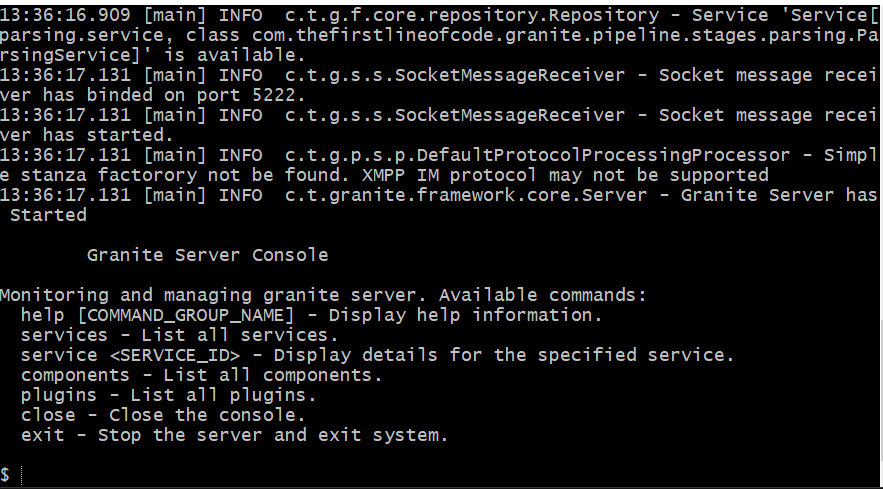
我们可以在Console输入services命令来检查Granite XMPP Server的状态。
$services
如果能看到所有的services的状态都是available,说明granite lite server已经被正常的启动了。
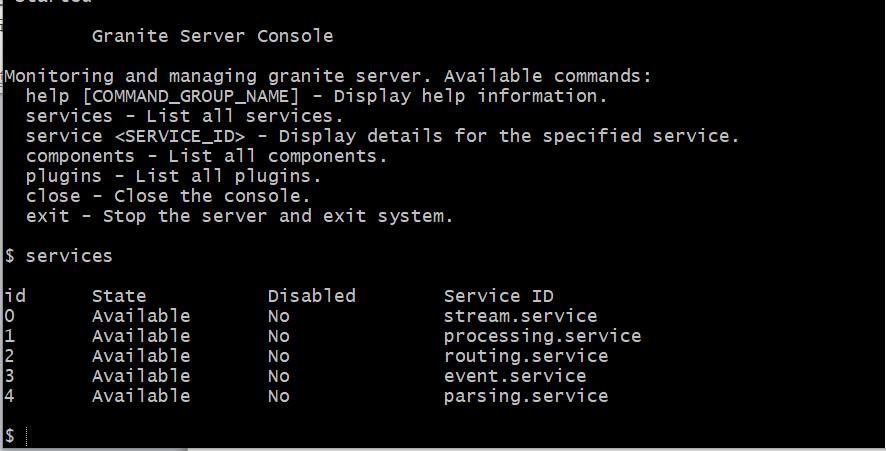
可以用plugins命令,来检查可用的plugins。
$plugins
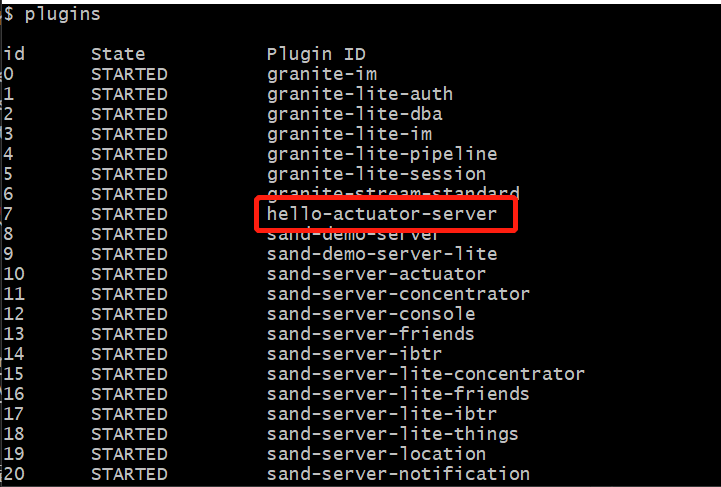
我们可以看到,hello-actuator-server插件已经被部署。
7.7 创建测试用户
在这里,我们还需要解决一个问题。
我们想使用手机App来遥控IoT设备闪灯,我们使用XMPP技术来做这件事情。
在XMPP标准里,要在XMPP网络里进行通讯,你需要一个XMPP账户。无论你是人还是物,你都需要一个账户。你是人,需要一个User账户。你是物,你需要一个Thing(IoT)账户。
我们需要一个User账户,这样,我们才能够从手机App,连接到XMPP网络中,这才有可能通过XMPP网络去遥控IoT设备。
有一个简单的办法,可以创建User用户。
我们在Granite Lite IoT XMPP Server里,默认部署了sand-demo-server插件。这个插件用来支撑完整的sand-demo演示程序。使用plugins指令,可以看到Granite Lite IoT XMPP Server部署了sand-demo-server插件。
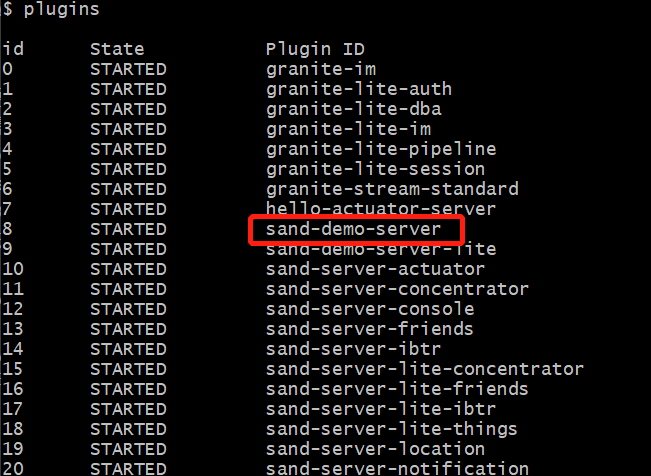
sand-demo-server插件,在Granite Server Console里提供了一个创建测试用户的指令,我们可以用它来创建测试用户。在Granite Server Console里,我们执行以下指令。
sand-demo create-test-users
我们会看到,测试用户已经被创建。
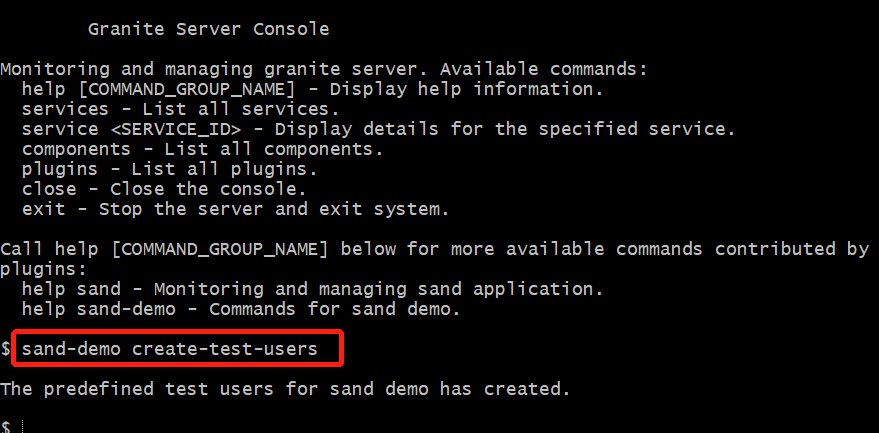
我们在这个教程后面,会使用测试用户sand-demo来登录手机App,进行遥控闪灯操作。
使用exit指令,可以退出Granite Server Console,并关闭Granite XMPP Server。
$exit
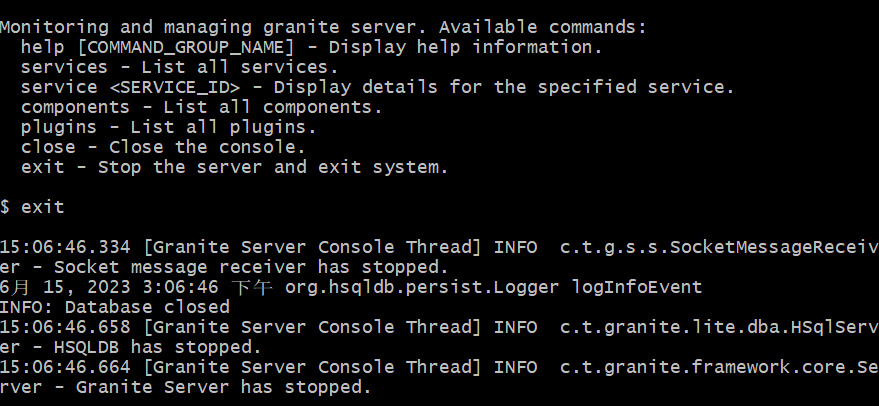
8 开发设备端程序
8.1 设备端工程
创建hello-actuator-thing目录,添加pom.xml文件。
<?xml version="1.0" encoding="UTF-8"?>
<project xmlns:xsi="http://www.w3.org/2001/XMLSchema-instance"
xmlns="http://maven.apache.org/POM/4.0.0"
xsi:schemaLocation="http://maven.apache.org/POM/4.0.0 http://maven.apache.org/maven-v4_0_0.xsd">
<modelVersion>4.0.0</modelVersion>
<parent>
<groupId>com.thefirstlineofcode.sand</groupId>
<artifactId>sand-client</artifactId>
<version>1.0.0-BETA3</version>
</parent>
<groupId>com.thefirstlineofcode.lithosphere.tutorials.helloactuator</groupId>
<artifactId>hello-actuator-thing</artifactId>
<version>0.0.1-RELEASE</version>
<name>Hello actuator thing</name>
<dependencies>
<dependency>
<groupId>com.thefirstlineofcode.sand.client</groupId>
<artifactId>sand-client-edge</artifactId>
</dependency>
<dependency>
<groupId>com.pi4j</groupId>
<artifactId>pi4j-core</artifactId>
<version>1.3</version>
</dependency>
<dependency>
<groupId>com.thefirstlineofcode.lithosphere.tutorials.helloactuator</groupId>
<artifactId>hello-actuator-protocol</artifactId>
<version>0.0.1-RELEASE</version>
</dependency>
</dependencies>
<build>
<plugins>
<plugin>
<groupId>org.apache.maven.plugins</groupId>
<artifactId>maven-jar-plugin</artifactId>
<version>2.4</version>
<configuration>
<archive>
<manifest>
<addClasspath>true</addClasspath>
<classpathPrefix>libs/</classpathPrefix>
<mainClass>com.thefirstlineofcode.lithosphere.tutorials.helloactuator.thing.Main</mainClass>
</manifest>
</archive>
</configuration>
</plugin>
<plugin>
<artifactId>maven-assembly-plugin</artifactId>
<version>3.0.0</version>
<configuration>
<appendAssemblyId>false</appendAssemblyId>
<descriptors>
<descriptor>src/assembly/descriptor.xml</descriptor>
</descriptors>
</configuration>
<executions>
<execution>
<id>make-assembly</id>
<phase>package</phase>
<goals>
<goal>single</goal>
</goals>
</execution>
</executions>
</plugin>
</plugins>
</build>
<repositories>
<repository>
<id>com.thefirstlineofcode.releases</id>
<name>TheFirstLineOfCode Repository - Releases</name>
<url>http://120.25.166.188:9090/repository/maven-releases/</url>
</repository>
</repositories>
</project>
代码说明
- POM继承com.thefirstlineofcode.sand:sand-client,以便复用父POM里的依赖配置管理。
- hello-actuator-thing是一个独立运行的Java程序。我们使用maven-assembly-plugin和maven-jar-plugin来打包和配置可这个可运行程序。
- 依赖com.thefirstlineofcode.sand.client:sand-client-edge库,我们使用Edge库来帮助终端设备进行设备注册和连接服务器。
<dependency>
<groupId>com.thefirstlineofcode.sand.client</groupId>
<artifactId>sand-client-edge</artifactId>
</dependency>
- 依赖pi4j-core库。我们用Pi4J库来访问控制硬件板的GPIO接口。
<dependency>
<groupId>com.pi4j</groupId>
<artifactId>pi4j-core</artifactId>
<version>1.3</version>
</dependency>
注:我们使用1.3版本Pi4J。因为Pi4J v1.4和Pi4J v2.x需要JDK 11。而我们在树莓派Zero W上,只安装了JDK 8。所以,我们使用Pi4J v1.3。
- 依赖hello-actautor-protocol协议包。
<dependency>
<groupId>com.thefirstlineofcode.lithosphere.tutorials.helloactuator</groupId>
<artifactId>hello-actuator-protocol</artifactId>
<version>0.0.1-RELEASE</version>
</dependency>
8.2 硬件控制
程序设计一个重要原则,责任原则。简单来说,我们将不同的责任划分到不同的接口和实现中,让它们各行其事。
在这里,我们也来划分责任。
我们先来关注硬件控制部分,我们想要控制IoT设备做亮灯、熄灯、闪灯。
Ok,先不管其它,我们来定义这个IoT设备的硬件控制的接口。
public interface ISimpleLight {
void turnOn();
void turnOff();
void flash(int repeat) throws ExecutionException;
}
注:
这种控制硬件的接口,在概念里,我们把它叫做Thing Controller,智能物件控制器。
hello-actuator-thing的核心类HelloActuatorThing,我们让它实现ISimpleLight接口。
public class HelloActuatorThing implements ISimpleLight {
private GpioController gpio;
private GpioPinDigitalOutput ledPin;
public HelloActuatorThing() {
configureGpio();
}
private void configureGpio() {
gpio = GpioFactory.getInstance();
ledPin = gpio.provisionDigitalOutputPin(RaspiPin.GPIO_08, "MyLED", PinState.LOW);
ledPin.setShutdownOptions(true, PinState.LOW);
}
@Override
public void turnOn() {
ledPin.high();
}
@Override
public void turnOff() {
ledPin.low();
}
@Override
public void flash(int repeat) throws ExecutionException {
if (repeat <= 0 || repeat > 8)
throw new ExecutionException(-1);
for (int i = 0; i < repeat; i++) {
flash();
try {
Thread.sleep(500);
} catch (InterruptedException e) {
throw new ExecutionException(-2);
}
}
}
private void flash() throws ExecutionException {
turnOn();
try {
Thread.sleep(200);
} catch (InterruptedException e) {
throw new ExecutionException(-2);
}
turnOff();
}
}
**代码说明
- 在configureGpio()方法里,我们使用Pi4J库对GPIO进行配置。我们配置使用ledPin变量来对LED灯的IN接口进行控制。
- 在turnOn方法中,我们调用ledPin.high(),拉高GPIO引针电压,这会让LED灯亮灯。对应的,在turnOff方法中,我们调用ledPin.low()来让LED灯熄灯。
Ok,现在,我们已经实现硬件控制了。
8.3 IoT通讯
让我们来给IoT设备添加通讯能力。
我们使用sand-client-edge库,可以简化设备端程序的编写。
让HelloActuatorThing继承AbstractEdgeThing。
public class HelloActuatorThing extends AbstractEdgeThing implements ISimpleLight {
public static final String THING_MODEL = HatModelDescriptor.MODEL_NAME;
public static final String SOFTWARE_VERSION = "0.0.1-RELEASE";
private IActuator actuator;
private GpioController gpio;
private GpioPinDigitalOutput ledPin;
public HelloActuatorThing() {
super(THING_MODEL, streamConfig, true);
configureGpio();
}
@Override
public String getSoftwareVersion() {
return SOFTWARE_VERSION;
}
@Override
protected void registerIotPlugins() {
chatClient.register(ActuatorPlugin.class);
}
@Override
protected void startIotComponents() {
startActuator();
}
private void configureGpio() {
... ...
}
private void startActuator() {
if (actuator == null) {
actuator = chatClient.createApi(IActuator.class);
registerExecutors(actuator);
}
actuator.start();
}
private void registerExecutors(IActuator actuator) {
actuator.registerExecutor(TurnOn.class, TurnOnExecutor.class, this);
actuator.registerExecutor(TurnOff.class, TurnOffExecutor.class, this);
actuator.registerExecutorFactory(createFlashExecutorFactory());
}
private IExecutorFactory<?> createFlashExecutorFactory() {
return new IExecutorFactory<Flash>() {
@Override
public Protocol getProtocol() {
return Flash.PROTOCOL;
}
@Override
public Class<Flash> getActionType() {
return Flash.class;
}
@Override
public IExecutor<Flash> create() {
return new FlashExecutor(HelloActuatorThing.this);
}
};
}
@Override
protected void stopIotComponents() {
if (actuator != null) {
actuator.stop();
actuator = null;
}
}
@Override
public void turnOn() {
... ...
}
@Override
public void turnOff() {
... ...
}
@Override
public void flash(int repeat) throws ExecutionException {
... ...
}
private void flash() throws ExecutionException {
... ...
}
@Override
protected String loadThingId() {
return THING_MODEL + "-" + ThingsUtils.generateRandomId(8);
}
@Override
protected String loadRegistrationCode() {
return "abcdefghijkl";
}
}
代码说明
- AbstractEdgeThing留下了一些抽象方法给子类来实现。这些抽象方法名字很直白,我们遵从方法名给出对应实现细节即可。
- registerIotPlugins()方法,在这里登记我们要使用的插件。因为这个IoT设备是一个可执行指令的Actuator。所以我们只需要注册ActuatorPlugin插件。
protected void registerIotPlugins() {
chatClient.register(ActuatorPlugin.class);
}
- startIotComponents()方法,Edge Thing连接到服务器后,会调用这个方法来启动设备。在这里,我们需要把Actuator组件启动起来,Actuator组件来自ActuatorPlugin。
我们在startActuator()方法里,创建IActuator实例,并注册Executors,最后调用Actuator的start()方法。protected void startIotComponents() {
startActuator();
} private void startActuator() {
if (actuator == null) {
actuator = chatClient.createApi(IActuator.class);
registerExecutors(actuator);
} actuator.start();
}
- 在registerExecutors()方法里,我们给TurnOn,TurnOff,Flash指令,注册它们对应的执行器。
有两种注册执行器的API。第一种API,我们直接将Action指令类,和Executor指令类,登记到Actuator。
注:
这里registerExecutor()方法的最后一个参数,是Thing Controller。
依据设计原则中的责任原则,Thing Controller负责直接控制IoT设备的硬件接口。在这里,Thing Controller是ISimpleLigh。
HelloActuatorThing实现了这个接口(ISimpleLight),提供控制硬件的turnOn(),TurnOff(),flash()方法。
我们把HelloActuatorThing当做第三个参数传给Actuator,Thing Controller会被注入给Executor使用。actuator.registerExecutor(TurnOn.class, TurnOnExecutor.class, this);
actuator.registerExecutor(TurnOff.class, TurnOffExecutor.class, this);
- 第二种API,我们注册一个Executor Factory,由这个Factory来提供相关信息以及创建Executor,这样可以更灵活的处理Executor的创建。我们使用这种API来创建FlashExecutor。
... ...
actuator.registerExecutorFactory(createFlashExecutorFactory());
... ... private IExecutorFactory<?> createFlashExecutorFactory() {
return new IExecutorFactory<Flash>() {
@Override
public Protocol getProtocol() {
return Flash.PROTOCOL;
} @Override
public Class<Flash> getActionType() {
return Flash.class;
} @Override
public IExecutor<Flash> create() {
return new FlashExecutor(HelloActuatorThing.this);
}
};
}
- 我们来处理一下设备注册的对应逻辑。还记得吗,我们在服务器端的Registration Customizer里,在检查Registration Code合法性时,使用的是一个硬编码的Registration Code。
所以,在IoT设备端,我们需要使用这个硬编码的Registration Code去注册。
我们重载loadRegistrationCode()方法,用写死的"abcdefghijkl"作为Registration Code去进行注册。protected String loadRegistrationCode() {
return "abcdefghijkl";
}
8.4 主程序
我们编写一个主程序来启动hello-actuator-thing。
public class Main {
private HelloActuatorThing simpleLight;
public static void main(String[] args) {
new Main().run(args);
}
private void run(String[] args) {
if (args.length == 1 && args[0].equals("--help")) {
printUsage();
return;
}
... ...
try {
simpleLight = new HelloActuatorThing();
} catch (IllegalArgumentException e) {
e.printStackTrace();
printUsage();
return;
}
... ...
simpleLight.start();
}
... ...
}
代码说明
- 很简单直白的代码,重要的是调用HelloActuatorThing的start()方法,将Edge Thing启动起来。
设备端程序已经开发完成,你可以参考官方开源仓库代码hello-actuator-thing设备端程序工程源码
8.5 构建部署hello-actuator-thing
用maven构建hello-actuator-thing
cd hello-actuator-thing
mvn clean package
将构建成功的设备端程序,copy到树莓派硬件板上。
scp target/hello-actuator-thing-0.0.1-RELEASE.tar.gz pi@192.168.1.180:/home/pi
注:
请将pi用户名,和树莓派网络ip 192.168.1.180,改为你自己环境的配置值。
8.6 启动thing程序
登录到树莓派上
ssh pi@192.168.1.180
运行thing程序
tar -xzvf hello-actuator-thing-0.0.1-RELEASE.tar.gz
cd hello-actuator-thing-0.0.1-RELEASE
java -jar hello-actuator-thing-0.0.1-RELEASE.jar --host=192.168.1.80
说明
- 启动thing程序之前,记得要先启动Granite XMPP Server。
- 第一次运行thing程序时,需要使用--host参数指定服务器地址。AbstractEdgeThing会记住程序启动参数,后续再启动thing程序,不需要再指定host。
- 程序启动后,会连接到服务器进行设备注册,注册成功后,登录到服务器
一切就绪后,可以看到Thing thing has started的提示。
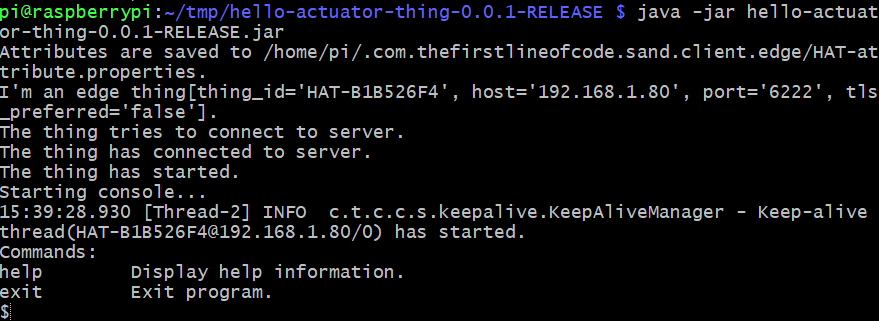
可以使用exit命令来退出hello-actuator-thing程序。
9 使用手机App遥控IoT设备
从头开发一个手机App比较繁琐,我们可以直接用Lithosphere平台提供的sand-demo App来遥控我们的IoT小灯。
你可以自己来构建sand-demo App,这是一个标准的Andriod工程,请用Andriod Studio来打开它。sand-demo App源码位于sand工程的demo/app-android子目录下。
你可以直接下载构建好的sand-demo App安装使用。
sand-demo App里大部分是常规的Android开发。创建菜单,画界面... ...
和IoT通讯相关的部分,是App使用Chalk的remoting插件来遥控IoT设备。
remoting插件的功能,是可以在远程设备上执行action指令。
remoting插件的使用较简单,以下代码,来自sand-demo App源码。
... ...
public void turnOn(JabberId target) {
logger.info("Turn on light {}.", target);
controlThing(target, new TurnOn(), "Turn on");
}
... ...
private void controlThing(JabberId target, Object action, String actionDescription) {
IChatClient chatClient = ChatClientSingleton.get(this);
IRemoting remoting = chatClient.createApi(IRemoting.class);
remoting.execute(target, action, new RemotingCallback(this, actionDescription));
}
... ...
private static class RemotingCallback implements IRemoting.Callback {
private final Activity activity;
private final String actionDescription;
public RemotingCallback(Activity activity, String actionDescription) {
this.activity = activity;
this.actionDescription = actionDescription;
}
@Override
public void executed(Object xep) {
activity.runOnUiThread(() -> Toast.makeText(activity,
actionDescription + " executed.",
Toast.LENGTH_LONG).show());
}
@Override
public void occurred(StanzaError error) {
String errorText = actionDescription + " execution error: " +
(error.getText() == null ? error.toString() : error.getText().getText());
remotingErrorOccurred(activity, error, errorText);
}
@Override
public void timeout() {
activity.runOnUiThread(() -> Toast.makeText(activity,
actionDescription + " execution timeout.",
Toast.LENGTH_LONG).show());
}
}
... ...
代码说明
- 用chatClient创建IRemoting实例,然后调用IRemoting的execute()方法。方法3个参数,第一个参数是远程设备的地址;第二个参数是要执行的action对象(Protocol Object);第三个参数,是RemotingCallback,我们用这个回调接口来处理远程指令执行结果。
IChatClient chatClient = ChatClientSingleton.get(this);
IRemoting remoting = chatClient.createApi(IRemoting.class);
remoting.execute(target, action, new RemotingCallback(this, actionDescription));
- 在RemotingCallback里,如果远程指令正常执行,会回调executed()方法;远程指令执行出错,会回调occurred()方法;远程指令执行超时(执行端未返回响应,不能确认指令是否执行成功),会调用timeout()方法。我们在这些回调方法里,做对应的处理。
... ...
@Override
public void executed(Object xep) {
activity.runOnUiThread(() -> Toast.makeText(activity,
actionDescription + " executed.",
Toast.LENGTH_LONG).show());
} @Override
public void occurred(StanzaError error) {
String errorText = actionDescription + " execution error: " +
(error.getText() == null ? error.toString() error.getText().getText());
remotingErrorOccurred(activity, error, errorText);
} @Override
public void timeout() {
activity.runOnUiThread(() -> Toast.makeText(activity,
actionDescription + " execution timeout.",
Toast.LENGTH_LONG).show());
}
... ...
如果想了解sand-demo App更多细节,请参考开源仓库里的sand-demo App程序源码
将构建好或直接下载的sand-demo App安装到安卓手机上。
启动sand-demo App。点击配置传输通道链接,进入stream配置页面。
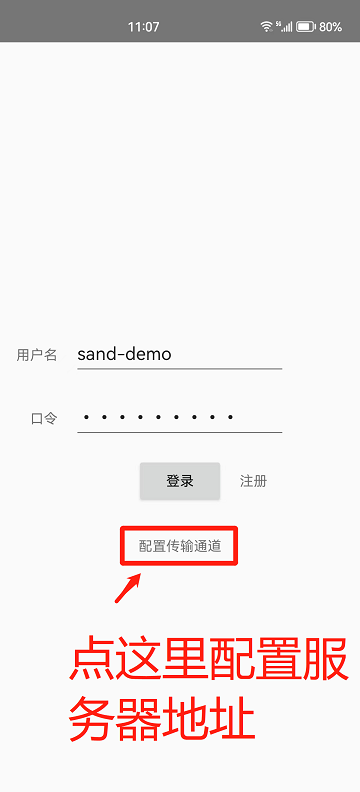
在传输通道配置页里,填写Granite XMPP Server的正确地址。

配置好传输通道后,回到登录页,使用sand-demo用户名来登录App。用户密码也是"sand-demo"。
登录后,可以看到注册成功后hello-actuator-thing。点击“控制这个智能物件”,会看到下拉菜单里,有Flash,Turn On,Turn Off三个子菜单。
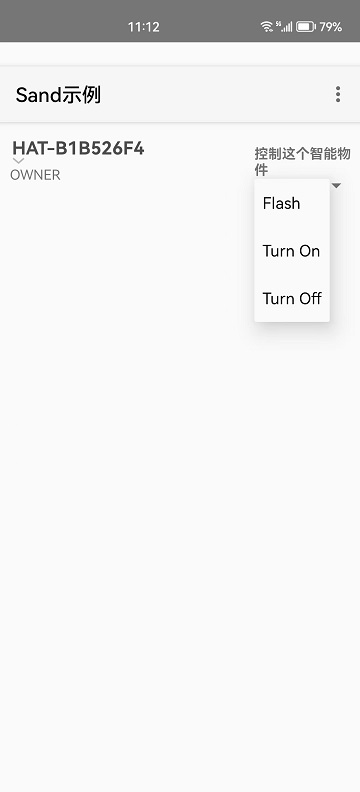
现在可以用手机App来控制hello-actuator-thing了。
10 总结
通过这篇教程,我们可以了解到以下的内容:
- 我们可以通过IoT硬件板上的GPIO接口,来控制IoT设备的外接硬件模块。
- 开源的Pi4J库,可以帮助我们使用Java语言来访问树莓派上的GPIO接口。
- 在IoT的世界里,有不同的通讯协议可以选择。在互联网端,XMPP协议是一个很好的选择。
- 如果使用Lithosphere,基于OXM(Object/XMPP Mapping)技术,我们不需要去处理XML,也不需要了解XMPP协议的细节。我们简单的创建Protocol Object来表达通讯指令。
- Lithosphere基于插件架构,我们可以通过创建服务器端插件,将我们要管理的IoT设备注册到系统中。我们还可以定制设备注册过程,以应对真实项目的需求。
- 在IoT设备端,我们开发Thing程序。使用Sand的sand-client-edge库,可以简化设备注册,服务器连接过程。我们只要注册需要使用的插件,编写Thing端处理逻辑。
- 对于Actuator(执行器)类型的IoT设备,我们使用actuator插件来简化开发。我们登记设备可执行的指令,并且注册指令所对应的Executor(执行器)。
- 我们在手机App端,使用remoting插件来远程执行指令,遥控IoT设备。
- 这篇教程里的内容,全部基于Java平台,只有Java,不涉及其它编程语言。
使用Java来开发物联网应用的更多相关文章
- 是的 你没看错!!!用JAVA为MCU开发物联网程序?
是的 你没看错!!!用JAVA为MCU开发物联网程序? 一直以来,物联网设备这种嵌入式硬件,对于Java软件开发者来说,就是Black Magic Box,什么中断.寄存器,什么 ...
- Java技术开发程序员如果在2019年立足
2019年的互联网环境相对以往来说要更复杂一些,互联网领域也正在经历从消费互联网向产业互联网转型的阵痛期.其实不少公司从2018年开始已经在陆续进行结构化调整,这些调整中的重要内容就是岗位调整,而岗位 ...
- 5款强大的Java Web开发工具
1.WebBuilder这是一款开源的可视化Web应用开发和运行平台.基于浏览器的集成开发环境,采用可视化的设计模式,支持控件的拖拽操作,能轻松完成前后台应用开发:高效.稳定和可扩展的特点,适合复杂企 ...
- Mac OS X上IntelliJ IDEA 13与Tomcat 8的Java Web开发环境搭建
这标题实在有点拗口,不知道怎么写好,但看了标题也就明白文本的内容.最近几天在折腾这些玩意儿,所以写写总结.除了环境搭建,本文还是一篇入门级的上手教程. 去下载一些东西 JDK安装 Tomcat安装 T ...
- 用Spring Boot颠覆Java应用开发
Java开发概述: 使用Java做Web应用开发已经有近20年的历史了,从最初的Servlet1.0一步步演化到现在如此多的框架,库以及整个生态系统.经过这么长时间的发展,Java作为一个成熟的语言, ...
- Java多线程开发系列之番外篇:事件派发线程---EventDispatchThread
事件派发线程是java Swing开发中重要的知识点,在安卓app开发中,也是非常重要的一点.今天我们在多线程开发中,穿插进来这个线程.分别从线程的来由.原理和使用方法三个方面来学习事件派发线程. 一 ...
- Java Web开发中MVC设计模式简介
一.有关Java Web与MVC设计模式 学习过基本Java Web开发的人都已经了解了如何编写基本的Servlet,如何编写jsp及如何更新浏览器中显示的内容.但是我们之前自己编写的应用一般存在无条 ...
- 【转】 java web开发之安全事项
从事java web开发也有几年了,可是开发中的安全问题却越来越不以为然.直到不久遇到一黑软,瞬间sql注入,少时攻破网站数据库.还好,我还没有用root级的用户连接数据库.不过也没有什么用了,因为我 ...
- [刘阳Java]_避开环境配置快速的使用Java的开发工具_第5讲
我们一般学习Java都应该遵循通过系统的命令工具来编译Java程序,然后对编译好Java程序进行运行,这个是非常好的习惯.但是随着后期学习Java技术的深入我们也得像Java的IDE工具屈服.所以,可 ...
- Java多线程开发技巧
很多开发者谈到Java多线程开发,仅仅停留在new Thread(...).start()或直接使用Executor框架这个层面,对于线程的管理和控制却不够深入,通过读<Java并发编程实践&g ...
随机推荐
- 2021-07-10:请返回arr中,求子数组的累加和,是<=K的并且是最大的。返回这个最大的累加和。
2021-07-10:请返回arr中,求子数组的累加和,是<=K的并且是最大的.返回这个最大的累加和. 福大大 答案2021-07-10: 时间紧.见代码. 时间复杂度:O(N*logN).空间 ...
- 2021-06-18:已知数组arr,生成一个数组out,out的每个元素必须大于等于1,当arr[cur]>arr[cur-1]时,out[cur]>out[cur-1];当arr[cur]>arr
2021-06-18:已知数组arr,生成一个数组out,out的每个元素必须大于等于1,当arr[cur]>arr[cur-1]时,out[cur]>out[cur-1]:当arr[cu ...
- 全网最详细解读《GIN-HOW POWERFUL ARE GRAPH NEURAL NETWORKS》!!!
Abstract + Introduction GNNs 大都遵循一个递归邻居聚合的方法,经过 k 次迭代聚合,一个节点所表征的特征向量能够捕捉到距离其 k-hop 邻域的邻居节点的特征,然后还可以通 ...
- 【GiraKoo】Java Native Interface(JNI)的空间(引用)管理
Java Native Interface(JNI)的空间(引用)管理 Java是通过垃圾回收机制回收内存,C/C++是通过malloc,free,new,delete手动管理空间.那么在JNI层,同 ...
- nginx发布vue 项目
在本次使用nginx发布vue项目遇到 配置location 始终404 和 在项目子目录点击浏览器刷新出现404问题 使用nginx发布vue项目,为了方便测试就下载了一个nginx 放置自己目录下 ...
- deepin系统更新谷歌浏览器chrome的方法
deepin系统更新谷歌浏览器chrome的方法 1 为什么要更新谷歌浏览器谷歌浏览器更新频繁,隔一段时间不更新,打开浏览器时会自动弹出一个提示更新的窗口,有点烦,如果使用python自动处理程序时, ...
- 自然语言处理(NLP)
"自然语言处理(Natural Language Processing, NLP)是计算机科学领域与人工智能领域中的一个重要方向.它研究能实现人与计算机之间用自然语言进行有效通信的各种理论和 ...
- 自然语言处理 Paddle NLP - 情感分析技术及应用-理论
自然语言处理 Paddle NLP - 信息抽取技术及应用 定义:对带有感情色彩的主观性文本进行 分析.处理.归纳和推理的过程 主观性文本分析:技术难点 背景知识 电视机的声音小(消极) 电冰箱的声音 ...
- SpringBoot 拦截器 & 过滤器
拦截器 Java里的拦截器是动态拦截Action调用的对象,它提供了一种机制可以使开发者在一个Action执行的前后执行一段代码,也可以在一个Action执行前阻止其执行,同时也提供了一种可以提取Ac ...
- 「学习笔记」Lambda 表达式
Lambda 表达式因数学中的 \(\lambda\) 演算得名, 直接对应于其中的 lambda 抽象. Lambda 表达式能够捕获作用域中的变量的无名函数对象, 我们可以将其理解为一个匿名的内联 ...
